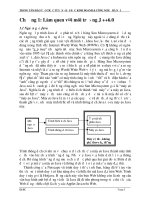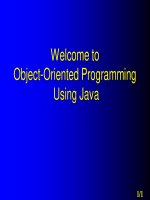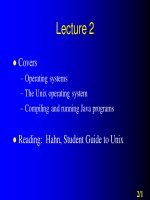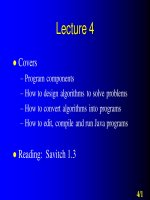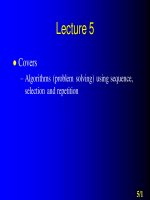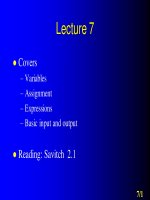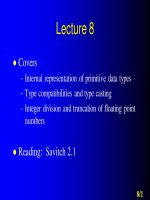Giáo trình Java cơ bản 03
Bạn đang xem bản rút gọn của tài liệu. Xem và tải ngay bản đầy đủ của tài liệu tại đây (880.76 KB, 44 trang )
Lecture 3
Covers
–
–
–
–
–
–
Object-oriented concepts
Objects, classes, attributes and operations
Methods, messages and message passing
Information hiding (encapsulation) and interfaces
Inheritance and polymorphism
Algorithms
Reading: Savitch 1.2
3/1
► Objects
3/2
Objects
In the object-oriented paradigm everything
is viewed as an object
An object is an entity that has a state and
behaviour
The data that describe an object’s state are
called its attributes
An object’s behaviour is defined by the
operations it can perform
3/3
pictures from www.amazon.com
Pop-up Toasters
3/4
Abstraction
Each toaster has many attributes (colour,
weight, height, price, etc.)
In fact, it is not possible to list all the
attributes of a toaster (or any object at all)
We usually need to describe only some of
its attributes - those that are of interest to us
from a certain viewpoint
Such a description is known as an
abstraction
3/5
A view of the toasters
Suppose we are now looking at the toasters
from the viewpoint of how they perform
their toasting function
Then, from this viewpoint, we may describe
them as shown in the next few slides
3/6
Toaster A
2 racks
Each rack holds 2 slices of bread
Darkness set at light
Racks are up
3/7
Toaster B
4 racks
Each rack holds 1 slice of bread
Darkness is set at medium
Racks are down
3/8
Toaster C
3 racks
Each rack holds 1 slice of bread
Darkness is set at medium-dark
Racks are down
3/9
Toaster D
2 racks
Each rack holds 1 slice of bread
Darkness is set at medium
Racks are up
3/10
Describing a Pop-up Toaster
Attributes are pieces of data that describe the
state of an object
They have a value at any given time
3/11
State and attributes
It is possible for two distinct objects to have
the same state, i.e. the same values for their
attributes
E.g. if my brother and I both buy the same
make and model of toaster and they are
currently in the same state, they are still
separate objects
3/12
Behaviour
The behaviour of an object, like its
attributes, is theoretically inexhaustible
We usually only need to describe the
behaviour of an object from a certain
viewpoint
In the object-oriented approach, we describe
the behaviour of objects in terms of the
operations they support
3/13
The behaviour of a Pop-up
Toaster
Is defined by the operations it supports
–
–
–
–
–
view darkness setting
change darkness setting
lower rack / start toasting
view rack status
stop toasting
3/14
► Classes
3/15
Classes
Classes describe a group of similar objects
They form a template for the creation of
instance objects
Creating an instance object from a class
template is called instantiation
Classes determine what attributes an
instance object of that type should have,
though each instance object may have
different values for each attribute
Objects are examples of a class
3/16
Pop-up Toaster class
PopUpToaster
numberOfRacks
rackSize
darknessSetting
rackStatus
getDarknessSetting( )
setDarknessSetting( )
getRackStatus( )
startToasting( )
stopToastingEarly( )
3/17
► Information Hiding
(also known as Encapsulation)
3/18
pictures and concepts from www.howstuffworks.com
How toasters work
Infrared radiation
Nichrome wire wrapped
across a mica sheet
Spring-loaded tray
Timer turns toaster off
and releases rack
Grates to centre bread
3/19
How toasters work
Handle connected to
rack to lower bread into
toaster
Electromagnet holds
racks down
3/20
How toasters work
Circuit board with
contacts
Variable resistor to
control rate at which
capacitor charges,
which controls length
of time before
electromagnet is
released (sets darkness)
3/21
How toasters work
When you push down on the handle,
– The plastic bar presses against the contacts and applies
power to the circuit board
– Power runs through the contacts to the nichrome wires to
start toasting the bread
– A circuit made up of transistors, resistors and capacitors,
turns on and supplies power to the electromagnet
– The electromagnet attracts the piece of metal on the
handle, holding the bread in the toaster
– The circuit acts as a timer. A capacitor charges and when
it reaches a certain voltage it cuts off the power to the
electromagnet. The spring pulls the two slices of bread up.
– The plastic bar rises and cuts off power to the toaster.
3/22
How toasters work
The darkness control is simply a variable
resistor.
– Changing the resistance changes the rate at
which the capacitor charges, and this controls
how long the timer waits before releasing the
electromagnet.
3/23
Using a toaster
To use a toaster, do you need to know how
the toaster works?
In fact most of the mechanism is hidden
from view
To use a toaster, we only need to be able to
use its controls (operations)
A pop-up toaster has few operations to
control it
We refer to the set of operations available to
its user as its interface
3/24
Information hiding
In the object-oriented paradigm, the details
of an object that do not need to be known to
use that object are hidden from view
A user is only allowed to know about the
details necessary to operate the object
The set of operations visible to a user of an
object is called the object’s interface
3/25


